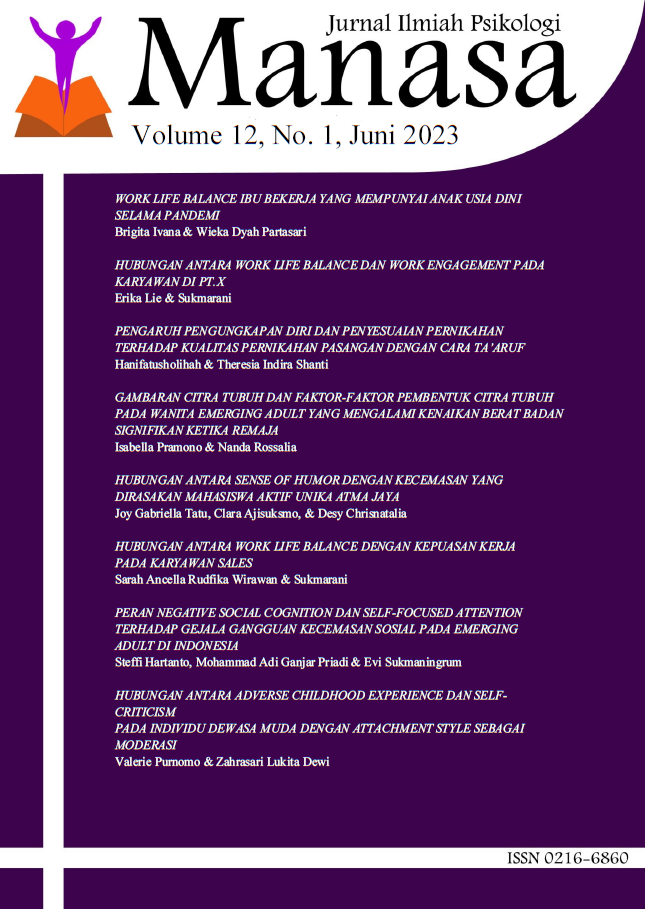PERAN NEGATIVE SOCIAL COGNITION DAN SELF-FOCUSED ATTENTION TERHADAP GEJALA GANGGUAN KECEMASAN SOSIAL PADA EMERGING ADULT DI INDONESIA
DOI:
https://doi.org/10.25170/manasa.v12i1.4154Keywords:
Social anxiety, negative social cognition, self-focused attention , emerging adulthoodAbstract
A strong fear of one or more social situations where one might be subject to criticism and scrutiny from others is a sign of social anxiety disorder. Untreated social anxiety disorder symptoms have been linked to risky conduct, including risky sexual activity, abuse of alcohol, tobacco, and other drugs, which peaks throughout the emerging adulthood stage. The key variables that contribute to the symptoms of social anxiety disorder are self-focused attention and negative social cognition, according to a number of cognitive theories. This study looked at the effects of self-focused attention and negative social cognition on social anxiety disorder symptoms in emerging adults in Indonesia. This study's design was a correlational study, and convenience sampling was used to choose participants who were between the ages of 18 and 25 and had at least a high school diploma. The Social Cognitions Questionnaire (SCQ), Self-Consciousness Scale (SCS), and Social Phobia Inventory (SPIN) were made available online to gather data. There were 124 people in all that took part in the study. The results of the multiple regression test reveal that while self-focused attention is not connected with social anxiety, negative social cognition significantly contributes to it. To research the connection between self-focused attention and symptoms of social anxiety disorder in Eastern nations, cultural factors like self-construal can be looked into.
References
American Psychiatric Association. (2013). Diagnostic and statistical manual of mental disorders. American Psychiatric Publishing.
Arnett, J. J. (2018). Conceptual foundations of emerging adulthood. Dalam Emerging adulthood and higher education (hlm. 11–24). Routledge.
Black, J. J., Clark, D. B., Martin, C. S., Kim, K. H., Blaze, T. J., Creswell, K. G., & Chung, T. (2015). Course of alcohol symptoms and social anxiety disorder from adolescence to young adulthood. Alcoholism: Clinical and Experimental Research, 39(6), 1008–1015.
Blöte, A. W., Miers, A. C., Van den Bos, E., & Westenberg, P. M. (2019). Negative social self-cognitions: How shyness may lead to social anxiety. Journal of Applied Developmental Psychology, 63, 9–15.
Blumenthal, H., Leen-Feldner, E. W., Babson, K. A., Gahr, J. L., Trainor, C. D., & Frala, J. L. (2011). Elevated social anxiety among early maturing girls. Developmental Psychology, 47(4), 1133.
Buckner, J. D., & Schmidt, N. B. (2008). Marijuana effect expectancies: Relations to social anxiety and marijuana use problems. Addictive Behaviors, 33(11), 1477–1483.
Campbell-Sills, L., Espejo, E., Ayers, C. R., Roy-Byrne, P., & Stein, M. B. (2015). Latent dimensions of social anxiety disorder: A re-evaluation of the Social Phobia Inventory (SPIN). Journal of Anxiety Disorders, 36, 84–91. https://doi.org/10.1016/j.janxdis.2015.09.007
Clark, D., & Wells, A. (1995). Cognitive Model of Social Phobia. Social Phobia, Diagnosis, Assessment and Treatment, Heimberg R, Liebowitz M, Hope D, Schneier F (Ed), New York. Guilford Press.
Connor, K. M., Davidson, J. R. T., Churchill, L. E., Sherwood, A., Weisler, R. H., & Foa, E. (2000). Psychometric properties of the Social Phobia Inventory (SPIN): New self-rating scale. British Journal of Psychiatry, 176(4), 379–386. https://doi.org/10.1192/bjp.176.4.379
Dahne, J., Banducci, A. N., Kurdziel, G., & MacPherson, L. (2014). Early adolescent symptoms of social phobia prospectively predict alcohol use. Journal of Studies on Alcohol and Drugs, 75(6), 929–936.
Davila, J., & Beck, J. G. (2002). Is social anxiety associated with impairment in close relationships? A preliminary investigation. Behavior Therapy, 33(3), 427–446.
Dinnel, D. L., Kleinknecht, R. A., & Tanaka-Matsumi, J. (2002). A cross-cultural comparison of social phobia symptoms. Journal of Psychopathology and Behavioral Assessment, 24(2), 75–84.
Evans, J. S. B. (2008). Dual-processing accounts of reasoning, judgment, and social cognition. Annu. Rev. Psychol., 59, 255–278.
Fehm, L., Beesdo, K., Jacobi, F., & Fiedler, A. (2008). Social anxiety disorder above and below the diagnostic threshold: Prevalence, comorbidity and impairment in the general population. Social psychiatry and psychiatric epidemiology, 43(4), 257–265.
Fenigstein, A. (2009). Private and public self-consciousness.
Fenigstein, A., Scheier, M. F., & Buss, A. H. (1975). Public and private self-consciousness: Assessment and theory. Journal of consulting and clinical psychology, 43(4), 522.
Hart, T. A., Tulloch, T. G., & O’Cleirigh, C. (2014). Integrated cognitive behavioral therapy for social anxiety and HIV prevention for gay and bisexual men. Cognitive and Behavioral Practice, 21(2), 149–160.
Heinrichs, N., Rapee, R. M., Alden, L. A., Bögels, S., Hofmann, S. G., Oh, K. J., & Sakano, Y. (2006). Cultural differences in perceived social norms and social anxiety. Behaviour research and therapy, 44(8), 1187–1197.
Hirsch, C. R., Clark, D. M., Mathews, A., & Williams, R. (2003). Self-images play a causal role in social phobia. Behaviour research and therapy, 41(8), 909–921.
Hofmann, S. G. (2007). Cognitive factors that maintain social anxiety disorder: A comprehensive model and its treatment implications. Cognitive behaviour therapy, 36(4), 193–209.
Kashdan, T. B., Collins, R. L., & Elhai, J. D. (2006). Social anxiety and positive outcome expectancies on risk-taking behaviors. Cognitive therapy and research, 30(6), 749–761.
Kemenkes, R. I. (2018). Hasil riset kesehatan dasar tahun 2018. Kementrian Kesehatan RI, 53(9), 1689–1699.
Kerlinger, F. N., Lee, H. B., & Bhanthumnavin, D. (2000). Foundations of behavioral research: The most sustainable popular textbook by Kerlinger & Lee (2000). Journal of Social Development, 13, 131–144.
Kessler, R. C., Berglund, P., Demler, O., Jin, R., Merikangas, K. R., & Walters, E. E. (2005). Lifetime Prevalence and Age-of-Onset Distributions of DSM-IV Disorders in the National Comorbidity Survey Replication. Archives of General Psychiatry, 62(6), 593–602. https://doi.org/10.1001/archpsyc.62.6.593
LeBlanc, N. J., Brown, M., & Henin, A. (2020). Anxiety disorders in emerging adulthood. Dalam Clinical handbook of anxiety disorders (hlm. 157–173). Springer.
Mallet, P., & Rodriguez-Tomé, G. (1999). Social anxiety with peers in 9-to 14-year-olds. Developmental process and relations with self-counsciousness and perceived peer acceptance. European Journal of Psychology of Education, 14(3), 387–402.
Markus, H. R., & Kitayama, S. (1991). Culture and the self: Implications for cognition, emotion, and motivation. Psychological review, 98(2), 224.
Marmorstein, N. R. (2012). Anxiety disorders and substance use disorders: Different associations by anxiety disorder. Journal of Anxiety Disorders, 26(1), 88–94.
Meral, Y., & Vriends, N. (2022). Self-image and self-focused attention in a social interaction situation: What is relevant for social anxiety? Behavioural and Cognitive Psychotherapy, 50(3), 269–279.
Mor, N., & Winquist, J. (2002). Self-focused attention and negative affect: A meta-analysis. Psychological Bulletin, 128(4), 638–662. https://doi.org/10.1037/0033-2909.128.4.638
Norasakkunkit, V., Kitayama, S., & Uchida, Y. (2012). Social anxiety and holistic cognition: Self-focused social anxiety in the United States and other-focused social anxiety in Japan. Journal of Cross-Cultural Psychology, 43(5), 742–757.
Perry, M. M. (2020). Understanding Social Anxiety Symptoms Through Interpersonal Emotion Regulation Strategies. The University of Mississippi.
Rapee, R. M., & Heimberg, R. G. (1997). A cognitive-behavioral model of anxiety in social phobia. Behaviour research and therapy, 35(8), 741–756.
Ryan, R. M., & Kuczkowski, R. (1994). The imaginary audience, self‐consciousness, and public individuation in adolescence. Journal of Personality, 62(2), 219–238.
Scott, K. M., de Jonge, P., Stein, D. J., & Kessler, R. C. (2018). Mental disorders around the world: Facts and figures from the WHO World Mental Health surveys. Cambridge University Press.
Singelis, T. M., & Sharkey, W. F. (1995). Culture, self-construal, and embarrassability. Journal of cross-cultural psychology, 26(6), 622–644.
Single, A., Bilevicius, E., Ho, V., Theule, J., Buckner, J. D., Mota, N., & Keough, M. T. (2022). Cannabis use and social anxiety in young adulthood: A meta-analysis. Addictive Behaviors, 107275.
Somerville, L. H., Jones, R. M., Ruberry, E. J., Dyke, J. P., Glover, G., & Casey, B. J. (2013). The medial prefrontal cortex and the emergence of self-conscious emotion in adolescence. Psychological science, 24(8), 1554–1562.
Torregrosa, J. R. (2004). Social psychology: Social or sociological?
Versella, M. V., Piccirillo, M. L., Potter, C. M., Olino, T. M., & Heimberg, R. G. (2016). Anger profiles in social anxiety disorder. Journal of Anxiety Disorders, 37, 21–29.
Vriends, N., Meral, Y., Bargas-Avila, J. A., Stadler, C., & Bögels, S. M. (2017). How do I look? Self-focused attention during a video chat of women with social anxiety (disorder). Behaviour Research and Therapy, 92, 77–86.
Vriends, N., Pfaltz, M. C., Novianti, P., & Hadiyono, J. (2013). Taijin kyofusho and social anxiety and their clinical relevance in Indonesia and Switzerland. Frontiers in psychology, 4, 3.
Wolitzky-Taylor, K. B., Arch, J. J., Rosenfield, D., & Craske, M. G. (2012). Moderators and non-specific predictors of treatment outcome for anxiety disorders: A comparison of cognitive behavioral therapy to acceptance and commitment therapy. Journal of Consulting and Clinical Psychology, 80(5), 786.
Wood, D., Crapnell, T., Lau, L., Bennett, A., Lotstein, D., Ferris, M., & Kuo, A. (2018). Emerging adulthood as a critical stage in the life course. Handbook of life course health development, 123–143.
Yu, M., Xu, W., Xie, Q., Zhu, Y., Chasson, G. S., & Wang, J. (2017). Automatic thoughts as a predictor of internalizing and externalizing problems in Chinese adolescents: A test of the cognitive content‐specificity hypothesis with age effects. Scandinavian journal of psychology, 58(5), 351–358.
Zimmermann, P., Wittchen, H.-U., Höfler, M., Pfister, H., Kessler, R. C., & Lieb, R. (2003). Primary anxiety disorders and the development of subsequent alcohol use disorders: A 4-year community study of adolescents and young adults. Psychological medicine, 33(7), 1211–1222.
Downloads
Published
Issue
Section
License
Copyright (c) 2023 MANASA

This work is licensed under a Creative Commons Attribution-NonCommercial-ShareAlike 4.0 International License.









.png)
.png)

